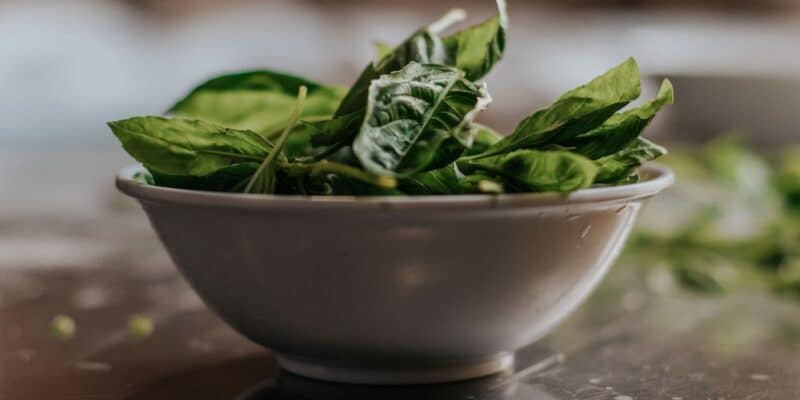The article will focus on whether or not it is safe for babies to eat spinach. It will discuss the nutritional benefits of spinach for babies, the appropriate age to introduce spinach to babies, and how to safely incorporate it into a baby’s diet. We will cover potential risks and precautions to be aware of when feeding spinach to babies, such as choking hazards and potential allergic reactions.
Introducing solid foods is an important milestone for babies as they grow and develop. While breast milk or formula provides essential nutrients for a baby’s first six months of life, solid foods become necessary as they require a more complex and varied diet for their overall health and growth.
Solid foods also help babies develop their motor skills, hand-eye coordination, and oral motor skills which are crucial for speech and language development. It allows them to explore new tastes and textures and develop their sense of taste, which can impact their food preferences in later life.
Furthermore, it provides essential nutrients such as vitamins, minerals, and fiber that may not be present in sufficient amounts in breast milk or formula alone. It is important to introduce a variety of solid foods to ensure that babies receive a well-balanced and nutritious diet that supports their healthy growth and development.
As an Amazon Associate, I earn from qualifying purchases. The links below may be affiliate links. Please read my disclosure policy for more information.
Can Babies Eat Spinach?

Yes, they can is the answer. Spinach is a nourishing food, that provides numerous vitamins and minerals crucial for the healthy growth and development of infants. Its high nutrient density and low-calorie count make it a valuable component of a baby’s diet.
To support a baby’s growth and development, spinach provides a rich source of vital vitamins, including vitamin A, vitamin C, vitamin K, and folate, as well as minerals such as iron, calcium, and magnesium.
Its antioxidant content shields the body from free radical damage and offers long-term protection from chronic diseases. Additionally, spinach is an excellent source of fiber that aids digestion and helps to prevent constipation in infants.
However, it is essential to ensure that babies are developmentally prepared for solid foods before introducing spinach. Signs of readiness include the ability to sit up without support, showing an interest in food, and the ability to swallow food.
It’s also important to consult with a doctor before introducing solid foods to ensure that the baby is healthy and ready for this milestone and has no signs of allergies or digestive problems before introducing spinach to their diet.
When introducing spinach, it’s best to start with small amounts, serving it in a pureed or mashed form to help babies gradually adjust to the taste and texture. Combining spinach with other fruits or vegetables can create a more palatable flavor for infants.
As babies mature and become more experienced eaters, spinach can be incorporated into their diets in various forms, including steamed or sautéed spinach. By the age of nine to twelve months, babies can consume a diverse range of foods, including leafy greens like spinach, which provide essential nutrients for their growth and development.
It’s also worth noting that spinach, along with other leafy greens, can contain nitrates, which can be harmful to babies when consumed in high amounts. Therefore, it’s important to avoid feeding them spinach that has been stored for too long or not prepared appropriately.
Parents should also introduce new foods one at a time to monitor the baby’s response for any signs of allergies or digestive problems.
Adding spinach to soups, stews, and other recipes can enhance their nutritional value, offering an easy and versatile way to incorporate this nourishing vegetable into a baby’s diet. Spinach can be blended into smoothies or pureed into dips, making it an enjoyable and healthy snack option for infants.
As babies grow older, they can enjoy a broader range of textures and flavors. Spinach, with its mild taste and tender texture, is an ideal vegetable for experimenting with different cooking methods and seasonings.
With proper preparation and mindful introduction, spinach can be a valuable addition to a baby’s diet, supporting their growth and development with its array of essential vitamins and minerals.
Adding Spinach To Your Baby’s Diet
When it comes to incorporating spinach into a baby’s diet, there are a few things to keep in mind to ensure that the spinach is prepared and served safely:
Choose Fresh Spinach
Look for fresh spinach leaves that are bright green and free from yellowing or wilting. This ensures that the spinach is at its peak freshness and nutrient content.
Thoroughly Wash the Spinach
Rinse the spinach leaves under running water to remove any dirt or debris. It’s important to ensure that the spinach is clean before preparing it for the baby.
Cook the Spinach
While babies can eat raw spinach, it’s a good idea to cook it before serving it to them. This makes the spinach easier to digest and reduces the risk of choking.
Steaming, sautéing, or boiling spinach until it is tender are all good cooking methods.
Puree the Spinach
For younger babies who are just starting solid foods, pureed spinach can be a good option. Use a blender or food processor to puree the cooked spinach until it is smooth and easy to swallow.
Offer Spinach as a Side Dish
As babies get older and start to eat more textured foods, cooked and chopped spinach can be served as a side dish. Mix it with other vegetables or grains for added flavor and nutrition.
Watch for Choking Hazards
Spinach can be a choking hazard, especially for younger babies. Make sure to chop it into small pieces or puree it until it’s smooth to avoid any choking risks.

Spinach is a versatile and nutritious food that can provide a variety of health benefits for your baby’s growth and development. From vitamins and minerals to antioxidants and fiber, spinach can help support a healthy and balanced diet for infants.
It’s crucial to introduce spinach in a gradual manner and at the right age, while also keeping a close eye on any signs of allergic reactions or choking hazards.
With proper care and guidance from a healthcare professional, parents can safely incorporate spinach into their baby’s diet and enjoy the many creative ways to make it a delicious and healthy addition to their meals.
Including spinach in your baby’s diet can be a great way to support their long-term health and well-being.
Here are some ideas for mixing spinach with other foods to create nutritious and tasty meals for babies:
Spinach and Sweet Potato Puree
Ingredients:
- 1 sweet potato
- 1 cup fresh spinach leaves
Instructions:
- Peel and chop the sweet potato into small pieces.
- Rinse and chop the spinach leaves.
- Steam the sweet potato and spinach until tender, for approximately 10-15 minutes.
- Add the steamed sweet potato and spinach to a blender or food processor and blend until smooth.
- Serve immediately, or store in an airtight container in the fridge for up to 3 days.
Spinach and Apple Puree

Ingredients:
- 2 cups chopped apples
- 1 cup fresh spinach leaves
Instructions:
- Rinse and chop the apples and spinach leaves.
- Add the chopped apples and spinach to a saucepan with enough water to cover the bottom.
- Cook on low heat for approximately 10-15 minutes, until the apples and spinach are soft.
- Transfer the cooked apples and spinach to a blender or food processor and blend until smooth.
- Serve immediately, or store in an airtight container in the fridge for up to 3 days.
Spinach and Banana Smoothie
Ingredients:
- 1 ripe banana
- 1 cup fresh spinach leaves
- 1/2 cup milk or yogurt
Instructions:
- Rinse and chop the spinach leaves.
- Peel and chop the banana.
- Add the spinach, banana, and milk or yogurt to a blender.
- Blend until smooth.
- Serve immediately, or store in an airtight container in the fridge for up to 1 day.

Spinach and Chicken Puree
Ingredients:
- 1 cup cooked chicken
- 1 cup fresh spinach leaves
Instructions:
- Rinse and chop the spinach leaves.
- Cook the chicken until tender, then chop it into small pieces.
- Add the cooked chicken and spinach to a blender or food processor.
- Blend until smooth.
- Serve immediately, or store in an airtight container in the fridge for up to 3 days.
Spinach and Rice Porridge
Ingredients:
- 1/2 cup uncooked rice
- 1 cup water
- 1 cup fresh spinach leaves
- 1/2 cup breast milk or water
Instructions:
- Rinse the uncooked rice and add it to a pot with water.
- Bring the water to a boil, then reduce the heat to low and simmer for approximately 15-20 minutes or until the rice is tender.
- Rinse and chop the spinach leaves, then add them to the pot with the rice.
- Cook for an additional 5-10 minutes, until the spinach, is wilted.
- Remove from heat and let cool slightly.
- Add the rice and spinach mixture to a blender or food processor and blend until smooth, adding a little breast milk or water to thin it out if needed.
- Serve immediately, or store in an airtight container in the fridge for up to 3 days.







